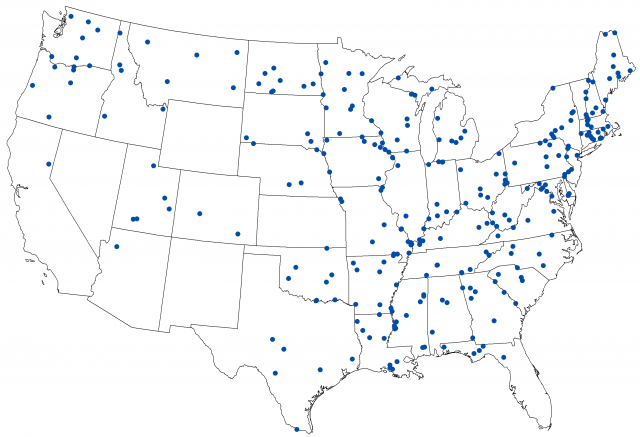2018-2019 National Rivers and Streams Assessment - Fish Tissue Study
Since 2008, the EPA has conducted a series of fish contamination studies as part of the Agency’s National Rivers and Streams Assessments that occur in five-year cycles. The 2018-2019 National Rivers and Streams Assessment (NRSA) Fish Tissue Study is the third statistically based national assessment of contaminants in fish from U.S. rivers. Each NRSA fish contamination study involves collection of recreational fish species from randomly selected river sites and analysis of fillet tissue for a variety of chemicals to evaluate the potential health impacts for people who eat fish.
Sampling Design
Sampling sites for the 2018-2019 NRSA Fish Tissue Study were randomly selected in rivers across the lower 48 states. Site selection for this study included rivers that are 5th order or greater in size (based on Strahler stream order) with a permanent fish population and flowing water during the study period from May through November (also referred to as perennial rivers). Only freshwater portions of tidal rivers were included in the study. A statistically representative set of 290 river sites were sampled for the 2018-2019 NRSA Fish Tissue Study.

Fish Sample Collection
Field crews used primarily electrofishing gear to collect fish composite samples from the 290 river sites sampled for the 2018-2019 NRSA Fish Tissue Study. A routine fish composite sample consisted of five fish that met the following criteria:
- All fish in the composite sample are of the same species.
- The fish species in the composite sample is commonly consumed by people.
- All fish in the composite sample either meet legal requirements of harvestable size for the sampled river or are at least of consumable size.
- All fish in the composite sample are similar in size, so that the smallest fish in the composite sample is not less than 75% of the total length of the largest fish in the composite sample.
- All fish in the composite sample are collected at the same time.
Various species of fish were collected for the 2018-2019 NRSA Fish Tissue Study. The three most frequently caught species include Channel Catfish, Smallmouth Bass, and Largemouth Bass. These three fish species accounted for 55% of the fish composite samples collected for this study.
Fillet Tissue Sample Preparation
Field crews shipped whole fish samples collected for the 2018-2019 NRSA Fish Tissue Study to a laboratory designated by the EPA for preparation of fillet tissue composite samples. Experienced laboratory staff filleted the fish (removing scales but retaining the skin and the belly flap on each fillet) and homogenized the fillet tissue in a strictly controlled environment to avoid contaminating the fish tissue samples. The homogenized fillet composite samples were divided into fillet tissue aliquots containing adequate tissue for each type of chemical analysis before being shipped to laboratories under contract to the EPA to analyze the fillet composite samples for the chemical contaminants included in the study.
Fillet Tissue Sample Analysis
- Mercury (total)
- Polychlorinated biphenyls or PCBs (all 209 congeners)
- Per- and polyfluoroalkyl substances or PFAS (33 compounds)
Commercial laboratories used the following chemical-specific methods for analysis of the 2018-2019 NRSA Fish Tissue Study fillet samples:
- Mercury: EPA Method 1631E, Mercury in Water by Oxidation, Purge and Trap, and Cold Vapor Atomic Fluorescence Spectrometry, EPA 821-R-02-019, August 2002.
- PCBs: EPA Method 1668C, Chlorinated Biphenyl Congeners in Water, Soil, Sediment, Biosolids, and Tissue by High Resolution Gas Chromatography/High Resolution Mass Spectrometry (HRGC/HRMS), EPA 820-R-10-005, April 2010.
- PFAS: Method using high performance liquid chromatography with tandem mass spectrometry (HPLC-MS/MS) procedures developed and tested by a commercial analytical laboratory; the EPA had no standardized method available for analysis of PFAS in tissue at the time of the study.
Results and Data
All results for the fillet tissue concentrations are reported on a wet weight basis. All the fish fillet samples analyzed contained detectable levels of mercury and PCBs, and PFAS were detected in 95% of the fillet samples.
Analytical and field sampling data for each 2018-2019 NRSA Fish Tissue Study chemical contaminant are provided, along with a data dictionary that describes the contents of each data file.
